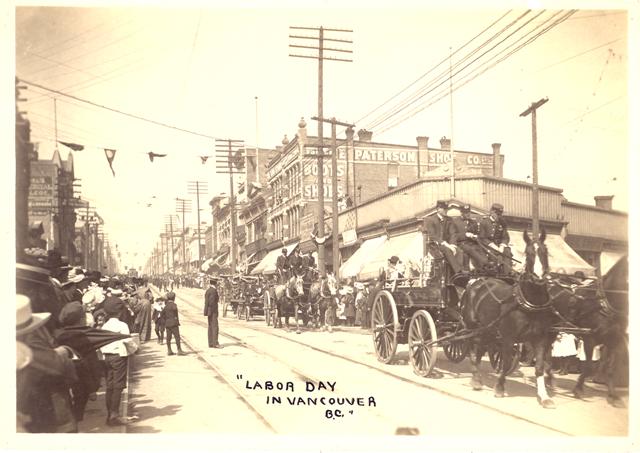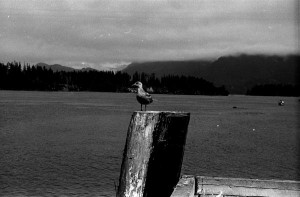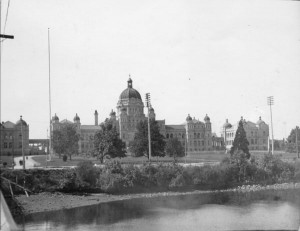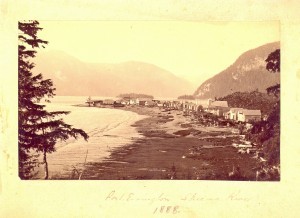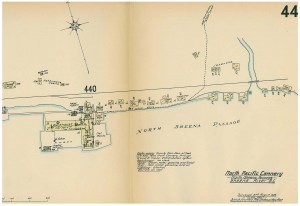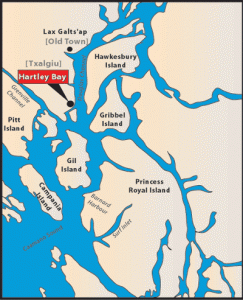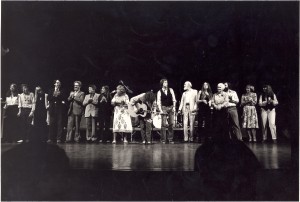The opening hours will be reduced in RBSC / University Archives effective July 30 – August 31. During this time period, RBSC (including the Chung Room) / UA will be open to the public from 10am – 4pm Monday – Friday. Please direct any RBSC-related questions to rare.books@ubc.ca . Please contact Chris Hives with any concerns about University Archives accessibility.
A reminder that all library branches including Rare Books and Special Collections, the Chung Collection and University Archives are closed on Monday September 5 for Labour Day.
The photograph above depicts a Labour Day parade in Vancouver, taken by Philip Timms in the early 20th century. The photograph is undated, but is believed to have been taken at the corner of Hastings and Cambie. RBSC has extensive holdings on the history of labour in British Columbia; try searching the library catalogue for the keyword “labour,” and limit your search to “Archival/mixed collections” (under “type”).
For more information on our historical photograph collections, please consult our Historical Photograph Research Guide, and for help with archival research, please consult our Archival Material Research Guide.
The Chung Collection Exhibition will be closed to the public from August 24-26 and August 29. We apologize for the inconvenience.
Summer is, believe it or not, coming to a close in 6 short weeks. Have you been to the beach yet?
For many in B.C., a trip to Tofino is synonymous with a trip to the beach. Located on the west coast of Vancouver Island, Tofino is the home of the world-famous Pacific Rim National Park and beautiful Long Beach. Major industries have traditionally included fishing and forestry, and in recent decades of course tourism, as visitors flock to the resorts and beaches in all seasons.
The photographs below are from the Chung Collection, held in Rare Books and Special Collections. The Chung Collection holds 8,000 historic photographs, many showing various locales in British Columbia. These photographs are both from an album of photographic negatives, taken during the 1930’s by an unknown photographer. While we do not know anything about the photographer or the origin of the photographs, it is a rich source of historic photographs. This album alone contains more than 1,400 photographs! They can all be found in the Chung Collection by searching for the identifier CC-PH-09370.
In the Irving K. Barber Learning Centre, the Tofino Meeting Room is number 156.
On Monday, August 1, we will celebrate British Columbia (BC) Day, a civic holiday. According to the Protocol and Events Branch of the British Columbia government, the “British Columbia Day Act, R.S.B.C. 1996 c.34 was first introduced in 1974 as Bill 61 by the Hon. Ernie Hall, the Provincial Secretary under Premier Dave Barrett. The explanatory notes prefacing the bill states: “The purposes of this Bill is to recognize the pioneers of British Columbia by declaring the first Monday of August in each year to be a public holiday known as British Columbia Day.”
The decision to make BC a holiday was debated during the 4th session of the 30th Parliament in 1974. This debate took place in the chamber of the British Columbia Parliament building.
The Parliamentary Room, room 155 in the Irving K Barber Learning Centre, was modeled after this room in the British Columbia Parliament. This room is quite different from a traditional lecture hall and is intended to support collaborative student learning and debate.
All of the staff in Rare Books and Special Collections wish you a happy and restful BC Day! Just a reminder that all of the UBC Library branches, including Rare Books and Special Collections, will be closed for BC Day. For more information on hours, click here.
The Skeena River Room, room 317 in the Irving K Barber Learning Centre, is a group study room that is named after the Skeena River, the second-longest river entirely within British Columbia’s borders (the largest being the Fraser River). Six-hundred and twenty-one kilometers long, it flows south and west through the Skeena and Coast Mountains, reaching the Pacific Ocean at Prince Rupert.
For thousands of years, the Tsimshian (“People of the Skeena”) have lived along the river; the Coastal Tsimshian live near the lower part of the river and the Gitksan live on the upper part of the Skeena River. George Vancouver visited the mouth of the Skeena River in July, 1793, but it wasn’t until the 1860s and 1870s that persons associated with the Gold Rush and railway began to travel to and settle along the river. In 1876, salmon canneries were built along the Skeena River. Operating along the river from the late 1870s to the mid-1980s, at one time there were as many as 18 canneries along the Skeena.
In Rare Books and Special Collections, we have various records and plans of salmon canneries that operated in British Columbia, and in particular along the Skeena River. For example, in the Inverness Cannery fonds, there are plans, financial records and correspondence relating to this cannery constructed along the Skeena River in 1873. The J.H Todd and Sons fonds also contains records concerning the Inverness Cannery.
It is also very interesting to consult the 1924 fire insurance plans of Skeena River salmon canneries in the collection of Plans of salmon canneries in British Columbia together with inspection reports on each, that are part of the records of the British Columbia Fire Underwriters’ Association. This collection includes the plans of 12 canneries that operated along the Skeena in the early 1920s: Inverness Cannery, North Pacific Cannery, Dominion Cannery, Sunnyside Cannery, Cassiar Cannery, Haysport Cannery, Alexandra Cannery, Balmoral Cannery, Port Essington Cannery, Carlisle Cannery, Claxton Cannery, and the Oceanic Cannery.
Fire insurance plans are detailed large-scale maps of cities, smaller municipalities, and industrial sites that were produced from the late 1800s to the mid-1960s. The object of these maps was to show the character of any insured building. These plans were compiled by the fire insurance underwriters to assist their agents in assessing and controlling the risks of fire. Various symbols and colours were used to indicate the following characteristics: the shape and size of a building; the type of construction used; the existence of fire protection facilities; and the use of the building (e.g., a restaurant, a laundry, etc.).
The fire insurance plan of the North Pacific Cannery is revealing for a number of reasons. In addition to documenting the number and types of buildings of this cannery originally established in 1889, the plan shows, for example, that in 1924, the Japanese, First Nations and Chinese cannery workers were housed in separate buildings:
This week, we are taking a closer look at the community of Hartley Bay — the community that the Hartley Bay Meeting Room (room 266), in the Irving K Barber Learning Centre is named after.
Hartley Bay is the home of the Gitga’at First Nation, members of the Tsimshian cultural group. A village of 200, accessible only by air or water, Hartley Bay is located at the mouth of Douglas Channel, about 630 kilometres north of Vancouver and 145 kilometres south of Prince Rupert.
On March 22, 2006, the people of Hartley Bay were the first responders to the passengers aboard the sinking BC Ferries Queen of the North. The community was recognized for their heroic actions by the Governor General on May 3, 2006 and received the Governor General’s Commendation for Outstanding Service.
The XWI7XWA LIBRARY, located at 1985 West Mall has a variety of material on the community of Hartley Bay, including material in their special collections. Contact Ann Doyle, head of XWI7XWA LIBRARY, for more information on accessing material in the special collections.
A new archival collection is now available at Rare Books and Special Collections: the Stefan Arnason fonds contains the diaries of an Icelandic immigrant who, like a Canadian version of Grapes of Wrath, packed up his family of thirteen in 1937 in a 1.5 ton Dodge truck and moved them from Pine Valley, Manitoba to Vancouver. The diary excerpt shown here describes their arrival in the Vancouver area- unable to find accommodations able to house such a large family, their first “home” in Vancouver was camping out in Central Park in Burnaby, which he initially described as a “forest near the Vancouver city limits.” The diaries continue from there to chronicle the family’s every-day life in Vancouver, including employment issues, family occasions, and even the weather. Stefan Arnason was an active diarist until his death in 1956.
The diaries and their transcriptions, as well as other notebooks and documents, have been made available for use here at RBSC through their generous donation by the descendants of Stefan Arnason. Most of the material is in English; some earlier diary entries are in Icelandic, but translations are available in the transcriptions.
Two archival collections at Rare Books and Special Collections which were updated over the summer:
Doris Shadbolt fonds: Doris Shadbolt (1918-2003) was a well-known figure in the Canadian art world for her curatorial work at the Vancouver Art Gallery, and her seminal works on Emily Carr and Bill Reid. A recent addition to this collection continues to show her influence as a researcher, lecturer and curator, but also offers a glimpse of Shadbolt as an artist in her own right. The files include sketchbooks, designs, and documents related to jewelery design. Click here to read the finding aid.
Literary Storefront fonds: The Literary Storefront was established in 1978 as a grass-roots literary centre for west coast and Canadian authors and poets (click here for a brief history). Before it dissolved in 1985, hundreds of readings,workshsops, lectures, and symposiums took place at the Literary Storefront. The addition to the archives includes tapes of readings by Canadian authors and poets such as David Watmough, Margaret Atwood, Jack Hodgins, W.P. Kinsella and Tom Wayman, and American authors/poets including Sylvia Plath, Ted Hughes Jack Kerouac and Lawrence Ferlinghetti. Photographs show readings, events, and everyday life at the Storefront. Click here to read the updated finding aid.
Rare Books and Special Collections is well-known for our extensive collections on labour in British Columbia. We were excited therefore to see a new digital collection from the University of Saskatchewan on labour in that province. The collection contains over 2,494 images or textual documents scanned from over 32 fonds and collections at 8 different archival institutions. Users can search, or browse by theme or occupation. Visit the site by clicking here.
RBSC’s labour union records include the International Union of Mine, Mill and Smelter Workers, the Industrial Workers of the World Vancouver Branch, the Service, Office and Retail Workers Union of Canada and many others. To find others, search the RBSC site for the keywords “labour union.”
Search This Blog
- October 2013
- July 2013
- May 2013
- April 2013
- March 2013
- February 2013
- January 2013
- December 2012
- November 2012
- October 2012
- September 2012
- August 2012
- July 2012
- June 2012
- May 2012
- April 2012
- March 2012
- February 2012
- January 2012
- December 2011
- November 2011
- October 2011
- September 2011
- August 2011
- July 2011
- June 2011
- May 2011
- April 2011
- March 2011
- February 2011
- January 2011
- December 2010
- November 2010
- October 2010
- September 2010
- July 2010
- June 2010
- April 2010
- March 2010
- February 2010
- October 2009
- July 2009
- September 2008
- July 2008
- August 2007
- August 2006
- July 2006
- February 2006
- April 2005
- March 2005
- February 2005
- July 2004
- April 2004
